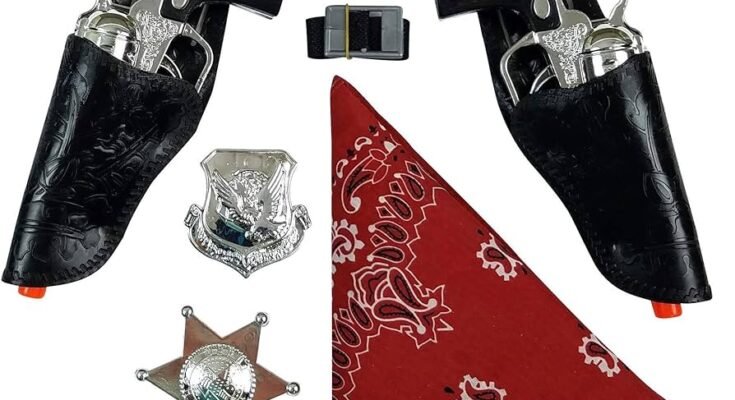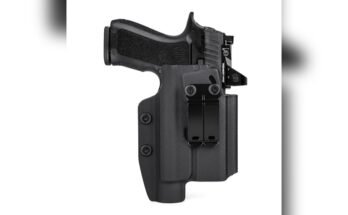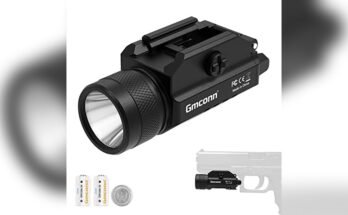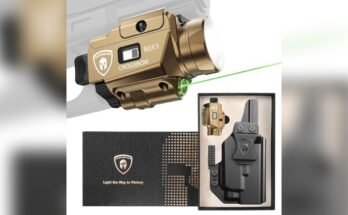If you carry daily, you’ve likely seen the telltale shine on high spots, the rubbed slide edges, or a faint line near the muzzle. Yes, holsters can damage a gun’s finish. As someone who has carried everything from parkerized .45s to DLC-coated compacts, I’ve seen how material, fit, and routine matter. In this guide, I’ll break down what actually causes wear, how to reduce it, and what’s normal versus a red flag. Let’s get practical, honest, and evidence-based about holster wear.

What Actually Damages A Finish?
Holster wear is simple physics and chemistry. Friction, pressure, and contamination meet time. Every draw and reholster creates micro-abrasion. Add dust, sweat, or grit, and the wear speeds up.
Key forces at play:
- Mechanical abrasion. Tight retention points rub the same spots on the slide, barrel hood, and trigger guard.
- Entrapped debris. Sand, lint, and carbon act like fine grit between the holster and finish.
- Moisture and salts. Sweat and humidity attack bluing and phosphate finishes if they sit under a holster all day.
- Heat cycling. Body heat, sun in the car, and range sessions expand and contract materials, loosening debris and increasing rub.
Holster wear is normal with real carry. The goal is to slow it and prevent corrosion, not expect showroom looks forever.

How Different Holster Materials Affect Finish
Not all holsters are equal. Material and fit drive most of the outcome.
- Kydex and other rigid polymers. Very durable and consistent. They can create crisp wear lines where retention presses the gun. They do not absorb moisture, but they can trap dust. Smooth interiors help.
- Leather. Softer and gentle out of the box. Over time, leather can compress, absorb sweat, and hold grit. Poorly tanned leather or heavy dyes can affect metal if the gun stays wet.
- Nylon and fabric hybrids. Often softer on contact, but seams, stiffeners, and hardware can create unexpected hot spots. Fabric can soak sweat.
- Suede or microfiber linings. Feel gentle, but they can trap abrasive particles. Without cleaning, they can become sandpaper.
Fit matters more than the label. A well-fitted Kydex with polished contact points can outlast a loose leather rig that carries sweat and dust.

Carry Style, Environment, And Wear Patterns
Where and how you carry shapes the wear you see.
- Inside-the-waistband (IWB). More sweat and body heat. Expect edge wear on the slide, muzzle end, and high spots near the ejection port.
- Outside-the-waistband (OWB). Less sweat exposure, but more contact with jackets or belts. Retention points create defined rub lines.
- Appendix carry. Higher moisture and movement. Pay extra attention to daily wipe-downs.
- Duty and training use. More draws per week. Holster channels and retention devices leave clear marks.
Environment matters:
- Hot and humid. Accelerates corrosion on bluing and parkerizing.
- Dusty or sandy. Grit gets everywhere and speeds abrasion.
- Cold and wet. Condensation from temperature swings demands quick drying and oiling.

Source: www.amazon.com
Coatings And Gun Finishes: Which Hold Up Best
Some finishes shrug off wear better than others.
- Nitriding treatments (e.g., Melonite, Tenifer, QPQ). These harden the steel surface and resist corrosion and abrasion well.
- DLC, PVD, and similar hard coatings. Excellent hardness and slickness. Often show minor polishing before real wear.
- Cerakote and other baked-on coatings. Good corrosion resistance. Can chip or thin at sharp edges with repeated contact.
- Parkerizing and bluing. Classic, serviceable, but less resistant to sweat and abrasion. Need oil and care.
- Stainless steel. Resists rust, but still shows polish lines and can discolor if salt sits unchecked.
No finish is magic. Even the best coatings will show holster polish where contact is constant. The goal is to avoid deep scratches and corrosion.
Maintenance, Cleaning, And Prevention Tips
Small habits make a big difference. Here’s what has worked for me over years of EDC and range instruction.
Daily
- Quick wipe-down. Use a soft cloth to remove sweat, fingerprints, and lint after carry.
- Light oil film. On steel slides and controls, a thin rust preventive helps. Avoid over-oiling; it attracts dust.
Weekly
- Clean the holster. Blow out dust, brush seams and retention areas, and wipe interiors. For Kydex, a damp microfiber works. For leather, use a dry brush and a leather-safe cleaner sparingly.
- Inspect contact points. Look for sharp edges or burrs on the holster. Lightly smooth sharp plastic ridges with fine sandpaper if the maker allows.
Monthly
- Deep clean the gun. Strip, clean, and re-lube per the maker’s manual.
- Treat leather. Use a quality leather conditioner sparingly to avoid softening retention.
Smart gear choices
- Choose a holster with smooth interior and consistent retention.
- Add a light-bearing holster if you run a weapon light; it often shifts contact to tougher areas.
- Use sweat guards and wear a moisture-wicking undershirt for IWB in summer.
Fast fixes
- Painter’s tape on high-wear edges during high-volume training can reduce scratch risk. Replace often.
- Consider a slide wrap or protective film for training blocks if cosmetic wear matters to you.
When Wear Is Normal Versus A Problem
Normal wear
- Polished edges on the slide and muzzle.
- Faint lines where the holster’s channel rides.
- Slight color change on parkerized or blued guns where contact is constant.
Warning signs
- Rust freckles or pitting under grips or near the ejection port.
- Flaking or lifting of coatings beyond sharp corners.
- Deep gouges from a misfit holster screw or exposed hardware.
- Discoloration with rough texture, which hints at corrosion, not just polish.
If you see problems, stop carrying in that holster until you clear the cause. Clean, neutralize rust, and correct fit or hardware.
Cost-Benefit: Duty Use, EDC, And Safe Queens
Be honest about your goal. A working gun will show working wear.
- Duty and high-volume EDC. Expect finish polish. Prioritize function, retention, and safe draws. Choose hard finishes and durable holsters.
- Occasional carry. You can lean toward leather or lined holsters and slower wear, with diligent maintenance.
- Collector or safe queen. Use a silicone-treated gun sock, minimal handling, and non-abrasive storage. Train with a clone or slide replacement if appearance is key.
A little honest wear tells a story. It is not a failure. It is proof of practice and readiness.
Frequently Asked Questions Of Can Holsters Damage A Gun’s Finish?
Do Kydex holsters wear finishes faster than leather?
Kydex often creates sharper, more defined wear lines at retention points. Leather can seem gentler at first but may hold moisture and grit. Fit, cleanliness, and environment matter more than material alone.
Can I prevent holster wear completely?
No. You can slow it with smart holster choice, regular cleaning, and light oiling. Any real carry and training will create some finish polish.
Is holster wear only cosmetic, or can it harm reliability?
Most wear is cosmetic. Reliability risk appears when debris builds up, rust forms, or a holster’s hardware gouges critical edges. Keep gear clean and check fit.
What finish holds up best for daily carry?
Nitrided treatments and quality DLC/PVD coatings tend to resist abrasion and corrosion well. Stainless slides also help, but they still show polish.
How often should I clean my holster?
Wipe it weekly if you carry daily, and after any sandy or dusty exposure. Clean more often during hot, sweaty months.
Will a lined holster protect my gun’s finish?
It can help, but linings can trap grit. Keep the lining clean or it will act like fine sandpaper.
Does a sweat guard make a difference?
Yes. It reduces direct contact with skin and sweat. Pair it with breathable clothing and daily wipe-downs for best results.
Conclusion
Holsters can damage a gun’s finish, but most wear is normal, predictable, and manageable. Choose a holster with smooth contact and proper retention. Keep the gun and holster clean. Favor durable finishes if you carry daily. Watch for rust and deep scratches, not mere polish marks.
Make a simple plan today: wipe down after carry, clean your holster this week, and inspect contact points. Small habits protect your investment and keep your firearm ready. Want more guides like this? Subscribe, share your experience in the comments, and let me know which holsters have treated your finish best.



